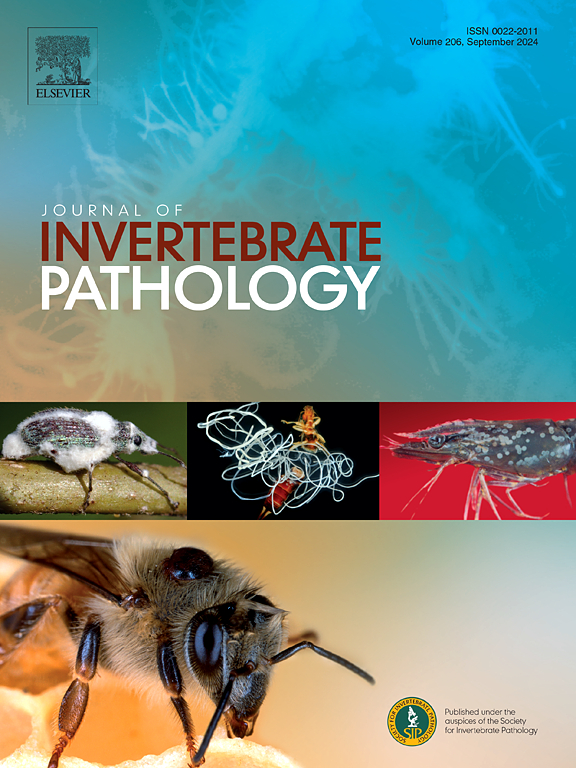智利南部紫贻贝(Mytilus chilensis)播散性瘤变的流行病学研究。
IF 3.6
3区 生物学
Q1 ZOOLOGY
引用次数: 0
摘要
本研究调查了智利南部洛斯拉各斯地区紫贻贝(Mytilus chilensis)播散性瘤变(DN)的患病率和特征。DN是一种恶性增生性疾病,已在贻贝属的几个物种中被描述。对2016年至2022年间在不同地理区域(Calbuco-Hueihue, Castro, Quellón)和季节(冬春、夏秋)收集的4000多只养殖和天然贻贝进行了组织学分析。根据肿瘤细胞的数量和侵袭器官的数量,评估了DN的患病率,并定义了三个严重程度。对肿瘤细胞和血细胞进行形态学和形态测定。分析了健康和肿瘤个体中粒细胞和透明质细胞的细胞核直径和核质比。3期肿瘤细胞的大小明显大于1期。总体平均患病率为3.4%,不同地区差异显著,Calbuco-Hueihue(5.59%)高于Castro(3.78%)和Quellón(1.40%)。Calbuco-Hueihue的冬春季患病率(7.79%)显著高于夏秋季患病率(3.95%)。记录每个贻贝的性别、配子体发育阶段和脂肪颗粒(ADG)细胞状态,并与DN的严重程度阶段相关。对于DN的第1和第2阶段,可以识别出女性和男性,但在第3阶段几乎没有性别的证据。在贻贝的性腺状态中也发现了同样的趋势,DN的晚期与去势有关。ADG细胞状态在DN的第1期最高,到第3期数量和染色下降。健康贻贝的性别比例为雌性53.5%,雄性43.7%,雌雄同体1.6%,不确定1.3%。其中雌性占34.1%,雄性占16%,雌雄同体占2.2%,不确定贻贝占47.8%。雌性贻贝的DN发生率较高,但雌雄贻贝的严重分期相同。尽管总体患病率较低,但仍存在一些潜在风险,值得继续监测和进一步研究智利支原体弥散性瘤变。本研究为辣椒刺螺的流行病学研究提供了重要数据,为今后的水产养殖研究和管理策略提供参考。本文章由计算机程序翻译,如有差异,请以英文原文为准。

Epidemiological insight into disseminated neoplasia in Mytilus chilensis from southern Chile
This study investigates the prevalence and characteristics of disseminated neoplasia (DN) in Mytilus chilensis in the Los Lagos Region of southern Chile. DN is a malignant proliferative disease that has been described in several species of the genus Mytilus. More than 4.000 adult mussels, both cultured and natural, collected between 2016 and 2022 in different geographical areas (Calbuco-Hueihue, Castro, Quellón) and seasons (winter-spring, summer-autumn) were histologically analysed. The prevalence was assessed and three levels of severity of DN were defined, based on number of neoplastic cells and organs invaded. Morphology and morphometry of neoplastic cells and hemocytes were evaluated. Cell and nucleus diameters and the nucleus/cytoplasm ratio of granulocytes and hyalinocytes were analysed in healthy and neoplastic individuals. The size of neoplastic cells was significantly larger in stage 3 of neoplasia than in stage 1. The overall mean prevalence of DN in M. chilensis was 3.4%, significant differences were found between sites, being higher in Calbuco-Hueihue (5.59%) than in Castro (3.78%) and Quellón (1.40%). The prevalence was significantly higher in the winter-spring season (7.79%) than in the summer-autumn season (3.95%) in Calbuco-Hueihue. The sex, gametogenic stage, and Adipogranular (ADG) cells status were recorded for each mussel, and related to the severity stages of DN. For stages 1 and 2 of DN, females and males could be recognized, but in stage 3 almost no evidence of sex remained. The same trend was identified for the gonadal status, the advanced stages of DN were associated with castration of the mussels. The ADG cells status was highest at stage 1 of DN, declining in number and staining till stage 3. The sex ratio of healthy mussels was 53.5% female, 43.7% male, 1.6% hermaphrodite, and 1.3% indeterminate, for mussels with DN it was 34.1% female, 16% male, 2.2% hermaphrodite and 47.8% indeterminate. Occurrence of DN was higher in females, but the severity stages affected equally female and male mussels. Although the overall prevalence is low, there are some potential risks that warrant continued monitoring and further study of disseminated neoplasia in M. chilensis. This study provides important data on the epidemiology of DN in M. chilensis, which will inform future research and management strategies in aquaculture.
求助全文
通过发布文献求助,成功后即可免费获取论文全文。
去求助
来源期刊
CiteScore
6.10
自引率
5.90%
发文量
94
审稿时长
1 months
期刊介绍:
The Journal of Invertebrate Pathology presents original research articles and notes on the induction and pathogenesis of diseases of invertebrates, including the suppression of diseases in beneficial species, and the use of diseases in controlling undesirable species. In addition, the journal publishes the results of physiological, morphological, genetic, immunological and ecological studies as related to the etiologic agents of diseases of invertebrates.
The Journal of Invertebrate Pathology is the adopted journal of the Society for Invertebrate Pathology, and is available to SIP members at a special reduced price.

 求助内容:
求助内容: 应助结果提醒方式:
应助结果提醒方式:


